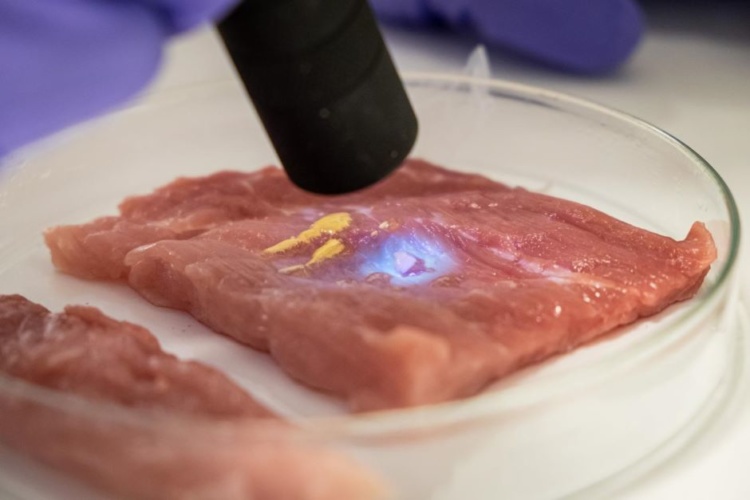
In a paper published in Biomaterials, researchers at Nanyang Technological University, Singapore (NTU Singapore) and clinicians from Singapore General Hospital showed that their glue can bond soft tissues including muscle and blood vessels, even when their surfaces are wet. The adhesive could serve also as a platform to deliver pain relief drugs.
New glue could replace surgical sutures and staples
CaproGlu is activated by a low dose of ultraviolet light that cures it in seconds, turning it from a liquid glue into a solid but flexible biorubber that can be resorbed by the tissue after a few weeks.
The team showed in animal experiments that blood vessels can be rejoined with four stitches and a mesh wrapper dipped in CaproGlu, compared to the eight stitches that are required for a reliable and unobstructed join.
CaproGlu can also be used to deliver local anaesthetics or pain relief medication to tissues in the body, which may be useful during and after an operation and would reduce the need for pain relief medication to be administered afterwards.
Unlike current bio-adhesives - which need two chemicals to be mixed prior to use - the CaproGlu is a one-pot liquid gel solution that comes ready-to-use.
Lead authors of the paper, Associate Professor Terry W.J. Steele and Senior Research Fellow Dr Ivan Djordjevic, emphasised that most surgical adhesives available on the market do not work in water or wet environments as found in the human body.
"To make our light-activated glue work on wet tissues, we engineered our glue to first remove water from the surface and thus allow adhesion to the dehydrated surfaces," Assoc Prof Steele said in a statement. "This unique advantage of being able to bond with high strength in a wet environment, as well as being biocompatible, is what makes CaproGlu so suitable to be used in surgery and medical applications."
The adhesion strength of CaproGlu was compared to other commercial bioadhesives and was found to be three to seven times stronger and is on a par with the shear strength of collagen and muscle tissue found in the human body.
CaproGlu combines two ingredients into a single-component formulation that does not require additives. The first is polycaprolactone, a biodegradable polymer which has been approved by the United States Food and Drug Administration for specific applications used in the human body; diazirine, a light-sensitive molecule that can form strong bonds when activated.
According to NTU Singapore, a big challenge for bioadhesives coping with the standard method by which surgical grade equipment and disposables are sterilised using gamma irradiation. The gamma sterilisation process destroys proteins and activates bonding in both acrylate and epoxy adhesives.
Unlike other surgical adhesives, CaproGlu's protein-free formulation is said to exploit new crosslinking chemistry unaffected by gamma sterilisation. The light-activated bonding mechanism forms chain links to amino acids at the nanoscale level, even after several months of storage and gamma sterilisation, making CaproGlu's production and commercialisation potentially less costly than those based on proteins and acrylates.
The biorubber glue innovation took five years to develop and is the subject of a provisional patent.




Red Bull makes hydrogen fuel cell play with AVL
Surely EVs are the best solution for motor sports and for weight / performance dispense with the battery altogether by introducing paired conductors...